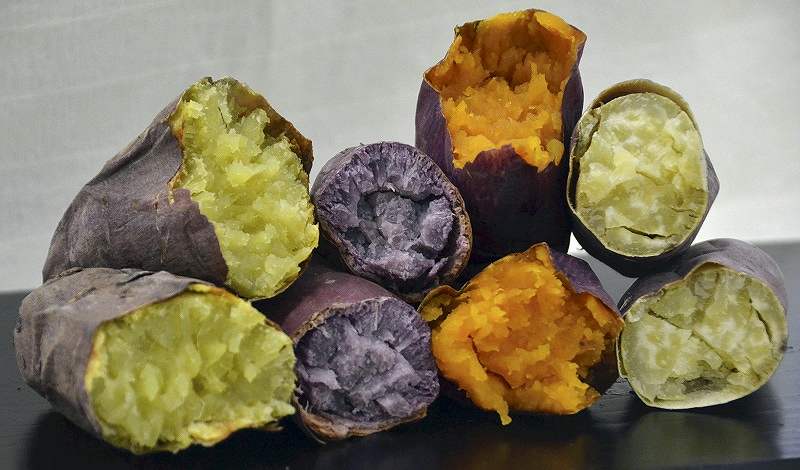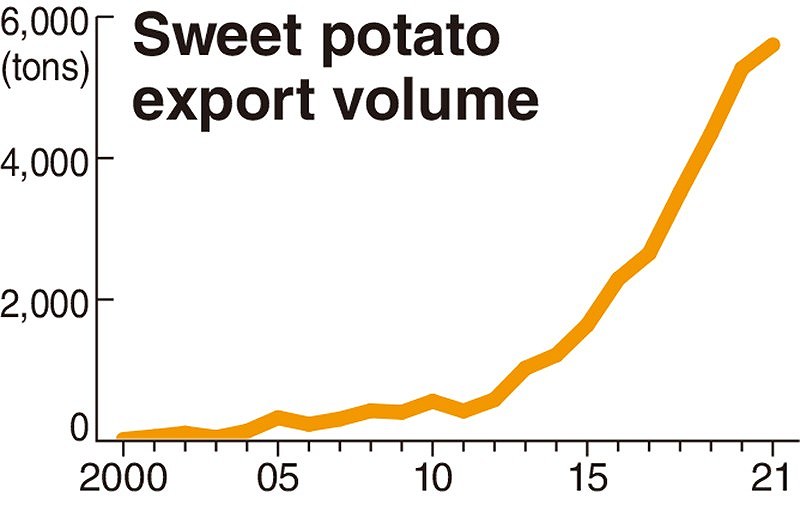
Yaki-imo sweet potatoes sold at Fuji. From left: Benimasari, Purple Sweet Lord, Halloween Sweet and Gorojima Kintoki varieties
7:00 JST, December 28, 2022
Yaki-imo baked sweet potatoes are enjoying a fourth wave of popularity thanks to stores offering a wider variety of the sugary tubers.
Some years ago, yaki-imo were a winter tradition sold out of trucks, but these days they are readily available at supermarkets and other shops. What’s the secret behind yaki-imo’s enduring appeal?
Yaki-imo sold at supermarkets
According to Ayuki Hashimoto, 44, president of the Sweet Potato Ambassador Association, which provides information on sweet potatoes, the first yaki-imo boom took place during the Edo period (1603-1867), when sweet potatoes first began to be widely cultivated. In an era when sugar was scarce, yaki-imo proved a hit.
The yaki-imo industry for the whole city of Edo was, by Hashimoto’s estimate, worth some ¥600 million in today’s currency.
After the Meiji Restoration, demand for inexpensive yaki-imo rose again with the rapid increase in population. This was the second boom. However, the draw of chocolate and other sweets during the Taisho era (1912-1926) dampened interest in yaki-imo.
The third boom began in 1951, the year sweet potatoes roasted over hot pebbles began to be offered in Tokyo. They were sold out of carts drawn by bicycle, or from trucks, and the convenience of buying from such vehicles aided in their revival.
With the expansion of fast food restaurants and convenience stores, however, cheap and appealing snacks became more accessible, and the popularity of yaki-imo declined once more.
The appearance of automatic yaki-imo ovens for commercial use in 1998 marked a turning point. It became possible to produce and sell yaki-imo at supermarkets and other stores. In 2005, Maruetsu Inc., a supermarket chain operator with about 300 outlets mainly in the Tokyo metropolitan area, began selling yaki-imo in its stores in earnest using ovens. Currently, almost all of its stores sell the baked sweet potatoes.
Many other supermarkets have also introduced such ovens.

A yaki-imo baked sweet potato stand at a Maruetsu supermarket
Consumers likely feel less guilty about eating yaki-imo than they do high-calorie sweets — which has led to the fourth yaki-imo boom, a trend that continues to this day and is founded on the health consciousness of recent years.
Varieties galore
In the past, the leading yaki-imo varieties used to be flaky, but recently, silky sweet varieties have been winning the hearts of consumers.
In 2007, the National Agriculture and Food Research Organization applied to the agriculture ministry to register the Beniharuka sweet potato variety, a representative sweet potato of the flaky variety.
With the Annoimo variety grown in Tanegashima attracting a great deal of attention at the time, the Beniharuka variety, which has similar characteristics, quickly gained popularity.
New varieties such as Silk Sweet continue to pop up on the market, and sweet potatoes are becoming ever more diverse
At the yaki-imo specialty shop Fuji, which opened in Tokyo in 2013, customers stands in line when autumn comes to choose from among its eight or so yaki-imo varieties. In addition to shops that offer a wide variety of sweet potatoes, recent years have also seen some places lay emphasis on how they bake their yaki-imo.
Overseas sales steaming hot
Exports of sweet potatoes are thriving amid the growing popularity of silky sweet varieties overseas.
Export volume for sweet potatoes, which was about 20 tons in 2000, has continued to expand rapidly, exceeding 2,000 tons for the first time in 2016 and growing to about 5,600 tons in 2021.

The operating company of the discount store Don Quijote began selling yaki-imo in Singapore in 2017. The company brought ovens from Japan to bake the sweet potatoes and offer them hot and ready to eat to customers.
The sales volume for yaki-imo that are sweet and silky, characteristics rarely seen overseas, has increased as much as sixfold from their initial sales volume.
“Yaki-imo have experienced a boom and bust cycle with the emergence of powerful rivals such as fast food and sweets, but now there seem to be no rivals. The yaki-imo craze will probably not cool down for some time,” Hashimoto said.
"Society" POPULAR ARTICLE
-

M4.9 Earthquake Hits Tokyo, Neighboring Prefectures
-

Israeli Tourists Refused Accommodation at Hotel in Japan’s Nagano Pref., Prompting Protest by Israeli Embassy and Probe by Prefecture
-

M7.5 Earthquake Hits Northern Japan; Tsunami Waves Observed in Hokkaido, Aomori and Iwate Prefectures
-

Tsukiji Market Urges Tourists to Avoid Visiting in Year-End
-

High School in Kyoto Says Students Shoplifted during Recent School Trip to Bali, Indonesia
JN ACCESS RANKING
-

Tokyo Economic Security Forum to Hold Inaugural Meeting Amid Tense Global Environment
-

Keidanren Chairman Yoshinobu Tsutsui Visits Kashiwazaki-Kariwa Nuclear Power Plant; Inspects New Emergency Safety System
-

Imports of Rare Earths from China Facing Delays, May Be Caused by Deterioration of Japan-China Relations
-

University of Tokyo Professor Discusses Japanese Economic Security in Interview Ahead of Forum
-

Japan Pulls out of Vietnam Nuclear Project, Complicating Hanoi’s Power Plans























